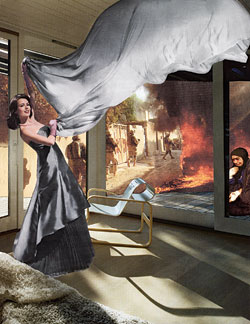
In the late sixties, Martha Rosler became known for a so-so series of collages titled “Bringing the War Home: House Beautiful.” She juxtaposed images of models, home décor, and the Vietnam War: A Vietnamese woman carried a bleeding baby in an unsullied American home, housewives dutifully cleaned battlefields, and so on. Although on a formal level Rosler simply mixed the harshness of John Heartfield’s thirties photomontages of the Third Reich with the pop-surreal sensibility of Richard Hamilton’s famous 1956 collage of a muscleman and a pinup girl in a contemporary living room, she did spice it with something new—an ironic, media-savvy attitude that changed the look of much art.
Four decades later, Rosler turns out not to have changed the look of her own work at all. In “Great Power,” her current skin-deep effort at Mitchell-Innes & Nash, Rosler tries to turn back the clock to her glory days, essentially remaking the Vietnam series. Only now she’s inserting images of models into pictures of the Iraq War. Clearly, there are parallels between the two wars, and activist art is valid. But Rosler lapses into simplistic nostalgia and undermines her older work while basically making pretty war porn. The only thing her work says is that fashion designers and women who like to shop caused two wars.
Rosler also includes news clippings about Iraq. Most of the articles are from reliably liberal sources (The Village Voice, The Nation, The New Yorker, etc.), so Rosler is merely filtering the already filtered. Worse, there’s an air of self-serving, pedantic preaching. She basically asserts that, while you may be concerned with current events, she’s so concerned she clipped these items and put them in binders. She turns President Bush’s “Go shopping” into “Start clipping.” To gain entry to “Great Power,” visitors must drop a quarter into a turnstile. The show’s press release states that this forces us to make “conscious decisions about how to engage with the work.” This is critique art putting a gun to its own temple. A sign at the door assures us that Rosler will donate all the quarters to antiwar groups. Anyone who thinks any of this is good art, effective activism, or even slightly radical needs to get a grip.
Rosler’s show is simply mediocre. What it points to, however, is far worse and more widespread. Too many younger artists, critics, and curators are fetishizing the sixties, transforming the period into a deformed cult, a fantasy religion, a hip brand, and a crippling disease. A generation is caught in a Freudian death spiral and seems unable to escape the ridiculous idea that in order for art to be political it has to hark back to the talismanic hippie era—that it must create a revolution. It is sophistry to think that everything relates to Europe and America in 1968. The very paradigm of revolution, of right versus wrong, good versus bad, is a relic with no bearing on the present. Yet artists, exhibitions, and curators valorize the sixties. People who wrote about these artists 30 years ago still write about them in the same ways, often for the same magazines. Their students and imitators are doing the same—writing about artists, sometimes the same ones, in the same ways their teachers did. Often for the same magazines.
It’s a trap set by a previous generation in order to preserve its legacy a little longer, or at least until its members relinquish their positions in academe, museums, and media. Many things happened in the sixties, but the period is no more significant, better, or more “political” than today. It’s time to turn the page.
Great Power
Martha Rosler
Mitchell-Innes & Nash. Through October 11.
E-mail: jerry_saltz@newyorkmag.com.